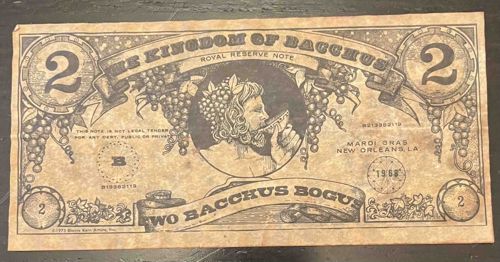
Two Bacchus Bogus Note - Mardi Gras New Orleans 1968
This item is a novelty or commemorative currency note, specifically a Bacchus bogus note, likely distributed during the Mardi Gras festivities in New Orleans. The note is rectangular, designed to mimic the appearance of a traditional banknote, but clearly denotes its non-legal tender status. Its color palette is a monochromatic sepia or brown tone, giving it an aged, parchment-like appearance. The central motif features a classical depiction of Bacchus (Dionysus), the Roman god of wine, with a prominent beard and flowing hair, adorned with grapes and grapevines. He appears to be playing a wind instrument, possibly a pan flute, which reinforces the festive and celebratory theme. Surrounding the central image are intricate grapevines and clusters, serving as decorative borders and fillers. Key textual elements include 'THE KINGDOM OF BACCHUS' prominently displayed at the top, along with 'ROYAL RESERVE NOTE.' The denomination '2' appears in large, ornate circles in the upper left and right corners, and in smaller circles in the lower left and right. A banner across the bottom reads 'TWO BACCHUS BOGUS.' Important identifying details include 'MARDI GRAS / NEW ORLEANS, LA.' and a date, '1968,' within a circular stamp-like design towards the right side. A clear disclaimer 'THIS NOTE IS NOT LEGAL TENDER / FOR ANY DEBT, PUBLIC OR PRIVATE' is printed on the left side, above a circular emblem containing the letter 'B.' Below this, the serial number 'B13362119' is visible, also duplicated on the right side. The bottom left corner has a small copyright mark '©1973 Blaise Kahn Among, Inc.' This discrepancy in years (1968 vs 1973) might indicate a print date for a note commemorating a past event. The paper shows signs of wear, including creasing and slight discoloration consistent with handling and age, confirming its vintage status. The overall craftsmanship suggests mass production, typical of souvenirs or parade throws, rather than fine art printmaking, but with a deliberate antique aesthetic.
AI-Generated Appraisal Disclaimer
Estimated Value
$10-25
Basic Information
Category
Commemorative Novelty Currency
Appraised On
December 5, 2025
Estimated Value
$10-25
Item Description
This item is a novelty or commemorative currency note, specifically a Bacchus bogus note, likely distributed during the Mardi Gras festivities in New Orleans. The note is rectangular, designed to mimic the appearance of a traditional banknote, but clearly denotes its non-legal tender status. Its color palette is a monochromatic sepia or brown tone, giving it an aged, parchment-like appearance. The central motif features a classical depiction of Bacchus (Dionysus), the Roman god of wine, with a prominent beard and flowing hair, adorned with grapes and grapevines. He appears to be playing a wind instrument, possibly a pan flute, which reinforces the festive and celebratory theme. Surrounding the central image are intricate grapevines and clusters, serving as decorative borders and fillers. Key textual elements include 'THE KINGDOM OF BACCHUS' prominently displayed at the top, along with 'ROYAL RESERVE NOTE.' The denomination '2' appears in large, ornate circles in the upper left and right corners, and in smaller circles in the lower left and right. A banner across the bottom reads 'TWO BACCHUS BOGUS.' Important identifying details include 'MARDI GRAS / NEW ORLEANS, LA.' and a date, '1968,' within a circular stamp-like design towards the right side. A clear disclaimer 'THIS NOTE IS NOT LEGAL TENDER / FOR ANY DEBT, PUBLIC OR PRIVATE' is printed on the left side, above a circular emblem containing the letter 'B.' Below this, the serial number 'B13362119' is visible, also duplicated on the right side. The bottom left corner has a small copyright mark '©1973 Blaise Kahn Among, Inc.' This discrepancy in years (1968 vs 1973) might indicate a print date for a note commemorating a past event. The paper shows signs of wear, including creasing and slight discoloration consistent with handling and age, confirming its vintage status. The overall craftsmanship suggests mass production, typical of souvenirs or parade throws, rather than fine art printmaking, but with a deliberate antique aesthetic.
Get Your Items Appraised
Instant estimates of your treasures with AI-powered instant appraisals